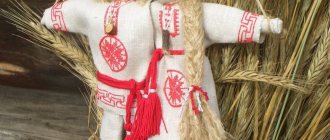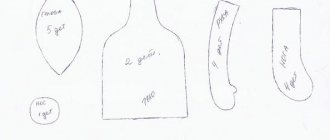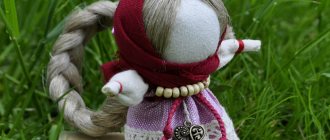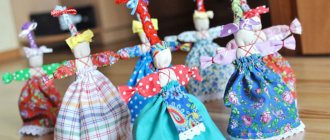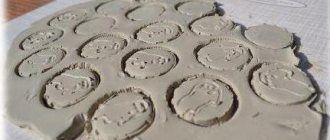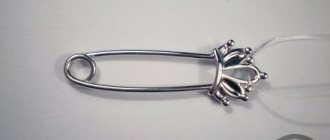Among the ancient amulets that came from Slavic culture, one stands out - the Blessed One, a cute hostess doll, so miniature that it can be hidden in a fist. She was affectionately called Brownie because she could talk to Brownie. The Do-It-Yourself doll, made by yourself, attracted good luck to the family and protected them from troubles. Today, many women strive to place little protectors in their homes so that there is always peace in the family and prosperity in the home.
The origins of the talisman of the ancient Slavs
The history of the Slavs is not calculated in a thousand years, as is commonly thought, but in a much longer period. The ancient people's perception of reality was called a magical picture of the world. Our ancestors got along with the forces of nature, knew about the existence of powerful gods and spirits, and created protective talismans. Knowledge of the worldview of our ancient ancestors helps us understand the image of the doll. The latest studies of Slavic mythology have established that long before the baptism of Rus', the traditional faith of the ancestors was Orthodoxy (to glorify Rule, the habitat of gods and righteous people). Hell, paradise, purgatory and other concepts of this series did not exist in the world order of the Slavs.
Through rituals, conspiracies, and amulets, people turned to their ancestors and gods, each of whom was responsible for their own sphere of life. The ancient Slavic calendar divided the year into palaces, united in the circle of Svarog. Each palace had its own amulet, which was patronized by the pagan gods. The palace was considered the house of God, to which a specific folk doll had to correspond. The Slavs created amulets on a date that guaranteed the protection of the deity. The Blessed Doll, made in the form of a figurine of a woman, belongs to the following sectors of the ancient Slavic circle.
| Name of the Hall | Patron | A period of time |
| Virgo | Goddess of life and well-being Jiva, symbol of kindness and youth | August 28 − September 19 |
| Pike | Rozhana. The goddess of comfort brings prosperity to the home | October 12 − November 2 |
| Swan | Makosh. Goddess of fate and fertility | November 3 − 23 |
| Elk | Goddess of beauty and family relationships Lada | May 7 − 29 |
| Race | Dazhdbog. Sunlight Guardian | August 4 − 27 |
Voodoo magic for wealth
If all the options for making a Voodoo doll for money do not suit you, this is not surprising - creating dolls is a rather complex procedure. But voodoo money magic, and in general this entire section of witchcraft in general, is not limited to this. There is an African ritual that will help you get money from certain people you know. These could be rich relatives or friends.
For the ritual you will need a coconut, from which you need to remove the pulp, leaving only a container of the peel. Prepare nine identical coins and red wine in advance. In addition, you will need special oil for lamps, which is now not very easy to obtain. Write the names of those from whom you are going to ask money on small pieces of paper in advance.
So, pieces of paper with names need to be placed in a coconut shell. Coins are laid out on top. Pour nine tablespoons of wine onto them. After this, you need to top up the lamp oil. Insert a wick into the coconut shell and light your improvised magic lamp. Light the lamp every day for nine days. It is required to use up all the liquid inside it. After that, you can safely go ask for money.
Features and secrets of the amulet
One of the most mysterious symbols of Russia is amulets, closely associated with pagan deities. The blessed woman (guardian of the home and family) is patronized by several goddesses of the Slavic pantheon, the most important of which are Lada and Bereginya.
- Lada. The goddess of prosperity, well-being, and beauty is often present in Slavic folklore. Constant epithets - guardian, patroness. Young girls turned to Lada for help to ensure the well-being of their future marriage. Married women used amulet to maintain peace in the family. Lada is considered the ancient Slavic Mother of God, whose image is preserved on many Christian icons (along with her son Lele).
- Bereginya. According to Vedic legends, women Reveal and Pravi are embodied in a special goddess. Reincarnation indicates the great capabilities of the amulet. The Creator of all spirits and earthly riches gives only worthy people well-being. Later, Slavic mythology turned the goddess into a translucent spirit. Beregins began to be called mermaids. According to legend, girls who died or committed suicide due to the fault of evil people became mystical creatures. Most Slavic peoples personified the image as a patron goddess and gave a name characterizing her purpose.
The housewife doll is made in a special way, has no face, and is dressed in clothes of a certain color and decor. Modern researchers have refuted the established opinion about the reasons for the creation of the faceless amulet. It was believed that in this way the evil spirits would not mistake the doll for a living creature and would not cause damage.
In the old days, a sacred object was not used to attract money. They wished for a lot of food, clothing, household utensils, health and happiness.
The symbolism of the product is explained differently: the folk doll Blessed One is located outside of earthly space, and is an intermediary between people and divine power. A talisman with several patron goddesses should not have a human face. It must be distinguished by names reflecting the purpose of the appointment.
According to archaeologists, women, as a symbol of motherhood, fertility, and protectors of the clan, played a special role in the lives of our ancestors. Therefore, the female image predominates in the protective dolls of the Slavs.
Etymological investigation
Philologists from the Institute of Slavic Studies of the Russian Academy of Sciences presented interesting information.
Many secrets are revealed with the help of the ancient Slavic initial letter as a source of information on Slavic history.
- A pagan is a people who revere traditions and gods, and are related according to certain criteria.
- The Slavs are a later word. Found in chronicles of the 5th century AD. Before this, the people were called Skolovens, i.e. solar (from colo, sun).
- A prosperous woman is a good half (good fate, good chance).
- Amulet - protect; a shore of land that protects from the elements.
- Doll - the word is derived from the ancient Slavic root “kuka”. Has several meanings:
- an unknown creature living in the dark;
- a ball of thread;
- rolled up bun;
- turn of the road, river or fate.
The Polish researcher of the secrets of the Earth L. Matela characterized the ancient people: they valued faith and freedom most of all, did not know power, and were indifferent to wealth. Russians, Ukrainians, Belarusians, Poles, Czechs, French, Irish, Scots and other Aryans are one people. The Slavs spoke different dialects, but they were united by similar beliefs, customs and rituals.
Why did people who valued nature and freedom (and not power and money) create a money doll?
Initially, the hostess Blagopoluchnitsa was not connected with money. She appeared in the house to bring goodness and happiness into the family. “Blago” translated from Old Church Slavonic means “good.” The second name “money” and the tradition of investing money in a talisman appeared at the beginning of the 18th century after the release of coins in denominations of 5 kopecks and 5 rubles.
It is customary to place a coin of 5 kopecks or 5 rubles at the bottom of the Blessed Lady, since this number has always been considered a symbol of prosperity and fertility, bringing good luck and happiness to the house.
The ancient Slavs believed that money was connected with the Moon. A useful thing, but for one day (day - gi). Righteous souls follow the sun's ray towards the Sun. The rest go with Veles to the Moon to cleanse themselves. Therefore, the Orthodox Slavs are “solar”, and the Western trading powers are “lunar”. The division occurred in ancient times, but even today the moon, as a symbol of attracting money, is present in magical rituals.
How to make a talisman magical
Magic was an integral part of the centuries-old traditions of the Slavs. Amulets were made only by women, whose witchcraft was based on the ability to control the intervention of spirits and mystical forces in human life. Turning to the pagan gods, experienced grandmothers created dolls and followed strict rules to endow the amulet with magical properties.
- For the sacrament, the presence of male energy and the intrusion of anyone into the manufacturing process were excluded.
- Spells and prayers were read over the product (the strongest ones were addressed to the Goddess Lada).
- A special role was given to embroidery, which was considered a magical amulet. Each had its own symbol and special meaning.
- To make the product magical, needlewomen must make the Blessed Lady with their own hands in the shape of a cross. Torso - vertical twist, arms - horizontal. In Slavic mythology, the cross was a symbol of the world tree.
- The face of a folk doll should be faceless. It is forbidden to draw eyes, nose, mouth.
- The amulet was passed down from generation to generation, absorbing the energy of the entire family.
- Special magical properties appear in the Blessed One on the days of the Goddesses: Lada - March 21, Bereginya - July 15.
Voodoo spell for money
Loa Spirit Idols
There is a simple Voodoo spell for money, but its reading requires the presence of a mask or figurine of Loa spirits. This is your link with the higher powers of voodoo. In order to ask for help in money matters, on a full moon night you need to drop your blood on a mask or figurine with the following words: The following spell can be cast at any time and in any environment. Even if you don’t have masks or figurines of voodoo deities. But they read it only in case of emergency, if financial matters really require help from higher powers: In general, Voodoo magic is quite strong. She can help you cope with any financial problems. However, Voodoo rituals are quite complex to perform, and often require components that are not easy to purchase in a regular or even esoteric store.
Rules and features of creating a talisman with your own hands
- The doll is created only by women without the presence of men.
- The magic item is performed at one time in a good mood.
- The Blessed Doll forever absorbs the energy of the master, who must put more warmth, tenderness, and love into the work.
- Bereginya cannot be chopped or cut. It is necessary to apply protective signs or symbols to the doll’s clothes in advance.
- Make a doll without scissors and needles from scraps, braid, threads.
- It is advisable to use one long thread.
- Knots are knitted only on the hands or in the navel area of the doll.
- It is forbidden to draw a face.
- The material must be wound clockwise.
- The important condition for creating a talisman is not the technique, but the image.
- After finishing work, read a spell or prayer.
Interesting fact
The validity of the requirement not to violate the canons when making amulets was indirectly confirmed by scientists. Doctor of Biological Sciences, Academician of the Russian Academy of Natural Sciences P.P. Garyaev discovered that DNA molecules produce genetic “music.” When the rhythms are converted by a computer, a mesmerizingly beautiful picture appears. After changing the experimental conditions (ultrasound intervention), the complex melody turned into one dull note.
Traditions are forever written in genetics. Secrets have been passed down from generation to generation, the violation of which turns the magical Bereginya into an ordinary toy.
Each amulet has its own phase of the moon
The Slavic amulet “Blessed One” is made during the growth of the Moon. On these days, all the elements unite, giving the figurine magical properties. Esotericists recommend taking the finished doll out into nature (preferably to a pond) and lighting a fire. Here water, fire, air, earth, when the owner of the amulet turns to them, will give the doll the necessary qualities. Do not hesitate to contact the elements that are ready to take part in the ritual.
Doll for happiness and good luck
Perhaps one of the most charming and famous Slavic amulets was the Doll for good luck. It's all about her long brown braid, which not only gives her the charm of youth, but also symbolizes a long and carefree life. And the longer the doll’s braid, the greater protective power it has.
After all, it is in a person’s hair, according to a long-standing popular belief, that all life force is concentrated. Under no circumstances should cut hair be thrown away or “thrown into the wind”; it was tied with threads and used in various ritual dolls or burned. And before the wedding, the groom bought his betrothed’s braid from the family, promising to be a good husband for his chosen one and make her happy.
Important: choose the right colors
For our ancestors, the use of different shades of color in amulets was a symbol, an opportunity to enhance the magical properties of a sacred object. The appearance of the image of a magic doll is explained by a rational position in relation to the revered goddesses of the Slavic pantheon. Therefore, when choosing a color scheme, you need to take into account the preferences of the main patrons of the Blessed One - Lada and Beregini.
- Colors of Goddesses: white, scarlet, yellow (gold), green.
- White is the color of the Gods, who radiate the light of holy wisdom. It is a symbol of goodness, luck, wealth.
- Red (scarlet) is a synonym for beauty, a symbol of life.
- Yellow is the color of the sun, gold, wealth.
- Green is the favorite color of the Beregins, whose symbols are the weeping willow and birch. Green denoted the Tree of the World.
For the amulet, the color is chosen depending on what qualities they want to endow the protector with.
Pattern: Embroidery Dolls Blessed One
Decorating the amulet doll
The magical properties of the doll are complemented by ancient symbols, embroidery, and wooden pendants with runes. Often a hostess's apron is used to place decor. In the old days, multiple combinations of minor details were used. For example, a small pot for honey was placed in the figurine’s hands. Ethnographers consider it acceptable to decorate the “money box” with coins, ornamental stones, and flowers.
In the pre-Christian period, in the center of Kyiv there was a temple of Lada. The sculpture depicted a beautiful goddess in a Russian sundress, belted with a belt made of precious minerals.
Features of handling the Blessed doll
Motanka is a family and personal amulets that require respect. The “money woman” begins to act if she feels a positive attitude and respectful attitude towards folk traditions.
It is important to treat a housewife with love, who brings prosperity and happiness to the house. The doll must be in the right place, undergo an activation ceremony, and receive gifts. You need to talk to her, treat her like a beloved family member. The amulet will respond to good relations with specific actions:
- will bring prosperity and well-being to the house;
- eliminate quarrels and conflicts;
- protects from negativity;
- will preserve feelings and health;
- will fill the house with positive energy.
Meaning
The main task of such a doll is to bring money and prosperity into the home. Welfare recipients were made to:
- girls studied the science of economics;
- men were successful in business;
- the long journey was successful and safe;
- find a rich groom for unmarried girls;
- protect family members from the evil eye.
It is customary to give dolls for weddings and housewarmings, so that the house will always be safe, nourishing and rich. The recipient will be an appropriate gift for any significant event in the family. It is believed that an important day accompanied by a talisman will be successful.
The home assistant is a female talisman. It is made by women and girls to protect the family, find a betrothed, and protect children.
For a prosperous woman, the number five is important - a symbol of prosperity. Nickels were placed inside the dolls, but now you can put a 50, 500 or 5000 ruble bill.
The appearance of the pupa also matters. Hands tied in a knot symbolize the reliability and safety of what is entrusted to the well-off woman. The doll has no face so that dark forces cannot inhabit it.
How to speak a talisman
- Bereginya will acquire magical properties after an activation ritual or conspiracy. Usually the ritual is performed at home alone with the doll.
- The sacred object is placed in the center of the table, with 3 wax candles placed around it.
- There are several options for the conspiracy: reading ancient Slavic spell texts; conversion to the goddess Lada; expressing a request in your own words.
- The necessary condition is sincerity and faith.
- The spell for the Well-Being doll involves a call to bring prosperity, joy, wealth, and protection to the house. It is recommended to insert the words into the text: housewife, housewife, comfort, table, food, help.
How to use it correctly: choosing the best place for the shore
The lucky one is not one of the amulets that need to be put away. The peculiarity of the doll is that it is 8 cm tall. The figurine can be placed anywhere: on a table, shelf, in the living room or in the kitchen. The “money woman” is considered the housewife’s assistant in household affairs, a friend (in some sources, wife) of the brownie.
In the old days, amulets were placed in the most honorable place - in the red corner. Some types of dolls were hidden from prying eyes so as not to show their desires.
The little doll can independently choose the best place for herself. To do this, they place it on the palm of your hand and mentally imagine possible habitat options. A hint will be the desire to place the amulet in your car, purse, on the fireplace or bedside table. If the call for a search was not received, it means that Bereginya trusted the person to choose the most suitable place for her.
Money Box
Another Slavic amulet for well-being and prosperity is considered to be the Kubyshka motanka. It is made using dry herbs, to which a coin is placed. This amulet is not only for wealth, but also for health, which is very necessary in moving up the career ladder.
With her curvy figure as a sign of health, and knots in her hands symbolizing accumulated wealth, Kubyshka is very popular among connoisseurs of Slavic amulets dolls. Having such a talisman in your apartment or office, you can enjoy the smell of fragrant herbs at any time. To do this, you just need to crush the reel with your hands.
When and to whom can you give the Well-Being?
The folk amulet is suitable for any person, because everyone wants happiness, health, joy, and prosperity. Items made for relatives have powerful energy.
- If the amulet was made by the hands of the mother, the amulet absorbs the memory of the family and should be given as a gift to the daughter or son.
- The Blessed One amulet doll is given as a gift for the New Year to bring good luck, joy, and wealth to the house.
- “Money” is presented on a birthday or housewarming.
- A wonderful gift to congratulate newlyweds.
You don't have to look for a reason. The lucky one will please every person and will provide magical protection in accordance with her mission.
Amulet for double profit
The history of the folk protective doll for double profit is very interesting. This motanka comes from the Kaluga province, which has preserved the traditions of making folk dolls to this day. They made such a talisman for a merchant for a new endeavor, so that the business would progress and bring a stable income.
The two babies that the doll holds in her hands symbolize double profit. After all, as you know, our most important wealth is children. The amulet contributes to both the successful running of an existing business and the promotion of a new brand.
RECOMMENDED: Maneki-neko: meaning and correct use
How to properly part with a doll, what to do if it is damaged
Faded fabric or a protruding thread are not considered an obstacle to the use of a sacred object. But if the doll falls apart and cannot be repaired, they say goodbye to the amulet. Among folk dolls, there are specimens that are necessarily burned after the fulfillment of a cherished dream (Zhelannitsa).
A prosperous woman who attracts wealth and good fortune is not completely destroyed. The doll is carefully “undressed”, the symbols are removed, and the threads are unwound. The material may be used for other purposes. When parting, they say words of gratitude and respect addressed to the beloved amulet.
Instead of a conclusion - the commandment of God Perun
Keep the memory of the traditions of your clans, and then your descendants will not forget you.
Master class: Do-it-yourself amulet doll Blessed One
Before creating a talisman, it is necessary to prepare in advance the materials that will be used in the work process.
Necessary materials
The well-being is made in size 7-8 cm.
We will need:
- A square of brightly colored fabric 23 by 23 cm for the body.
- A piece of white fabric 10 by 10 cm for the head.
- A rectangular piece of white fabric 6 by 15 cm for hands.
- A piece of fabric for an apron 5 by 9 cm.
- A square of beautiful thin fabric 20 by 20 cm for a scarf.
- Cotton wool or dry grass.
- 5-ruble or 5-kopeck coin.
- Ribbon or braid for a warrior.
- Threads, needle, scissors (if we make according to the rules, we use only threads that tear easily).
- 30-40 minutes of time.
Step-by-step instruction
- You need to roll a ball from a piece of cotton wool or straw.
- Place the resulting ball in the center of a piece of white fabric 10 by 10 cm and tie it with thread (it turns out to be the head of a doll).
- From a square of fabric 23 by 23 cm, cut out a circle and place a coin, cotton wool or dry grass in the center. Next, in a circle, stepping back 1 cm from the edge, sew it with thread, you get a bag (torso). If you make a doll according to the rules, then you cannot use a needle; the fabric must be gathered with your fingers and wrapped with thread.
- We connect the head with the body and tie it with thread.
- We tie a piece of fabric for the apron with threads to the neck of the bereginya.
- Take a rectangle of fabric for the hands and roll it into a tube 1 cm wide. Bend this tube in the middle and carefully tie a knot (it looks like hands clenched into fists).
- We connect the arms to the body (they can be sewn with a needle and thread to the back of the doll’s neck or tied with threads).
- We tie a warrior and a scarf on our heads. The Prosperous Moneymaker doll is ready.
Step-by-step diagram for making a Blessed Doll
Video Master class on creating a handmade Russian amulet doll
LiveInternetLiveInternet
Monday, March 03, 2014 03:20 + to quote book A doll that brings wealth and well-being to the house - “Krupenichka”.
Folk doll is a unique type of art that contains a sacred principle - traditions and rituals that have been passed down for many centuries within a family, from generation to generation. Each clan-family made them in its own way, investing all the love and accumulated centuries-old wisdom. They bore the imprint of the Spirit of this family, their Worldview and Attitude. Through the doll, a connection was established between ancestors and descendants, and secret ancestral knowledge was transmitted. Krupenichka is a doll that brings wealth and well-being to the house, creating warmth and comfort in it. This doll will be a good gift for a young family for a wedding or housewarming. Krupenichka was considered the main doll in the family. Our ancestors decorated it richly and carefully kept it for a year in the most visible place in the house. The basis of the doll was a bag of grain. In ancient times, these dolls were created after the harvest, filling them with selected grain collected from the field. This is where the sowing season began, first sowing the grain taken from this pupa. Traditionally, Krupenichka was filled with buckwheat, which symbolized satiety and wealth, but it can also be filled with other grains (for example, rice - an expensive “holiday” grain, or oats - a grain of strength).
To create “Krupenichka” you will need:
- unbleached linen fabric (for the body of our doll), ~ 20x20 cm; — cereal (I use buckwheat), ~ 1 cup; - linen or cotton fabric (for the undershirt), ~ 20x10 cm; - linen lace or linen/cotton fabric (for the outer shirt), ~ 20x10 cm; - linen or cotton fabric (for zipun), ~ 40x10 cm; — linen lace or linen/cotton fabric (for the warrior), ~ 20x10 cm; - linen or cotton fabric (for a scarf), ~ 40x20 cm; - linen lace and/or small pieces of fabric (for an apron), ~ 7-10 cm; - natural linen threads; - red floss; — copper fittings (to give the dolls expressiveness, I use pendants in the form of spoons, keys, etc.); - tailor's scissors; - scissors with a curly edge; - needle.
To create doll clothes, I recommend using a combination of plain fabrics with fabrics in small patterns. They look as organic as possible. In terms of color scheme, I recommend using fabrics of no more than 2 main harmonizing colors, shading them with fabrics of component colors. Our ancestors, instead of measuring instruments, used their parts of the body - elbow, span, fathom, etc. When measuring fabric, the same principle was used. 1 In order to create the body of our doll, we take unbleached linen fabric, place two palms on it side by side, measuring in this way a square ~ 20x20 cm.
Cut it out. Let me clarify right away - our ancestors did not use scissors when creating dolls. Pieces of fabric were torn off by hand, folded in different ways (depending on the specific type of doll), and tied with threads. However, to make the doll beautiful and neat, I still prefer to cut the fabric.
2 Fold the resulting square in half.
At a distance of 1 cm from the edge we sew together with natural linen thread. I leave the tails of the threads on both sides long and then tie knots from them by hand.
3. At the top and bottom of the bag, we gather the edge of the fabric with a basting stitch, leaving long tails of thread so that we can tighten them and tie them securely.
For the part of the bag that will be the top of the pupa, the tails of the threads should be on the inside of the bag (after we turn the bag inside out, they will accordingly be on the outside). This can be achieved if you insert the needle from the inside of the bag for the first time, and when you come to the last stitch, bring the needle and thread also to the inside. 4. We tighten the part of the bag that will be the bottom of the pupa, tie it with 3 knots, for reliability we wrap it with the rest of the thread and secure it with 3 more knots.
5. Turn the bag right side out.
6.Add the cereal. The body should be very dense, so we fill the bag full, leaving very little space to hide the tails of the fabric in it.
7.After we have hidden the remaining fabric inside, we pull it very tightly and tie it with 3 knots. \
8.Measure out the undershirt from the fabric. The shirt should cover 2/3 of our doll, i.e. hide it from the neck to the toes, leaving room for the face. To ensure that the bottom edge of the shirt is even, we will fold the fabric in half. Cut it out.
9. We wrap our doll, placing the edges of the fabric overlapping, thus covering the back seam of the bag. The seam will be the back of the doll's head.
10.Tightly wrap and secure the fabric with red thread. In ancient times, when creating a protective doll, all the storage joints of Zhiva (life-giving force) were tied with red thread to protect them
11.Measure and cut the linen lace for the outer shirt.
We wrap them over the bottom shirt so that the edges of the shirt do not meet on the front side, leaving a gap of about 3 cm. We gather them with linen thread and fasten them with 3 knots.
12. Let’s move on to creating a zipun (kaftan). Cut out a strip of fabric. The length of the strip depends on how thick the fabric itself is. If it is a thin strip, cut it longer; if it is dense, cut it shorter.
13. Take a copper pendant (for me this will be a key). We thread a linen thread into the eye and secure it firmly in the center with two knots.
14. Place a thread on the edge of the strip of fabric. And from the edges to the center we begin to twist the sleeves-handles, along with the thread and the key.
15. We put the resulting zipun on the doll in such a way that the edges of the twisted sleeves remain outside, and the height is located 1.5-2 cm above the bottom edge of the shirt. Wrap tightly and secure the zipun with linen thread. We tie it with 3 knots.
16. Throw the tail of the thread holding the key diagonally over the head, and using a needle carefully attach it to the thread that holds the zipun. We don’t prick the doll, and we don’t sew anything to it! We only need a needle so that we can wrap the thread from the key around the thread holding the zipun together. Secure with 3 knots
17. Let's move on to the apron. Cut out one or more small rectangular pieces of fabric and lace. If you want to make several fabric aprons, cut each one half a centimeter shorter than the previous one so that on the doll they can be seen one from under the other.
The apron can be secured in two ways. Our ancestors attached it like this:
For reliability, I prefer to thread a thread through it with a basting stitch and only then put the apron on the doll.
18.Cut out a strip of fabric for the warrior or take linen lace.
We wrap it around the doll's head, over the edges of the zipun, and secure it.
19.Then we cut out the triangle of the scarf. The tails of the scarf should be long and narrow enough, otherwise it will be very difficult to tie.
Let's get dressed.
And now our doll is ready. The owners welcome an assistant into the house. Good luck to you! Source
| Categories: | toys/dolls master classes folk doll, amulet |
Tags:
dolls folk doll master class
Cited 20 times Liked by: 7 users
Like share
0
Like
- 7
I liked the post - Quoted
- 0
Saved
- Add to quote book
- 0
Save to links
Liked7
0

